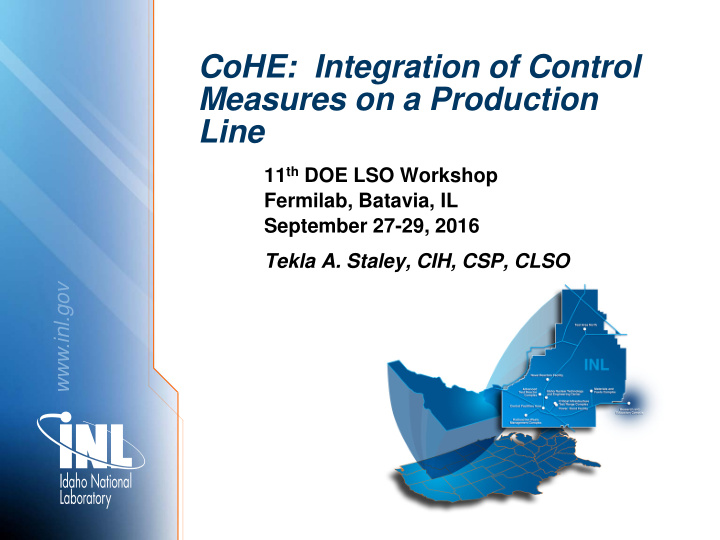



CoHE: Integration of Control Measures on a Production Line 11 th DOE LSO Workshop Fermilab, Batavia, IL September 27-29, 2016 Tekla A. Staley, CIH, CSP, CLSO www.inl.gov
How Do The Pieces Fit Together
Normal Production Operations • IF… the activity is determined to be a minor tool change, minor servicing or an adjustment to the equipment, during normal production operations, while the equipment is powered, • AND… these activities are routine , repetitive , and integral to the use of the equipment for normal production, • THEN… the activity may be performed using alternative measures which provide effective protection from hazardous energy sources. The activity is not subject to the requirements of 29 CFR 1910.147 (a)(2)(ii)
Maintenance • Preventive, predictive or corrective maintenance and servicing are NOT normal production operations. • Personnel may be exposed to unexpected startup or release of hazardous energy during the following activities: Construction Replacement Modification Installation Major adjustment Cleaning Repair Setup Inspection Lubrication Unjamming Tool Changes
Don’t Cross That Line Equipment Operating Boundary
Features of a Watch Station
Design Safety Features Pressure Sensitive Mats
Design Safety Features (cont.) K E Y E D G A T E S
Design Safety Features (cont.) Light curtains are interlocked to equipment with mechanical motion.
Alternative Controls Remote Pendant Control
Alternative Controls (cont.) Moving the gantry as close to the resonator as possible so the only direction it can move is away from the technician.
Alternative Controls (cont.) A NOTE ON AIR GAPPING • Does a hazard still exist if the production line is unmanned or shut down for an extended period? • Why? – Hazardous energy sources still exist, they are not locked out, and the system is still available for use. • Air gapping can be utilized to control those hazard during periods of extended non-use. • What is air gapping? – This is an engineered break in the system for long term standby. It prevents operation of the system, isolating the hazards so that personnel can access the EOB/EOZ without controls.
Administrative Controls (cont.)
Evaluate Your System What to do when LOTO is not feasible . . . Perform an ANSI Risk Assessment (ANSI B11.TR3.2000) RESIDUAL CONSEQUENCE/ RESIDUAL CONSEQUENCE/ PROTECTIVE MEASURES RISK LEVEL PROBABILITY RISK TASK HAZARDS PROBABILITY (Alternate Methods) (unmitigated) (after mitigation) (mitigated) Consequence → Probability of Catastrophic Serious Moderate Minor Occurrence ↓ Very Likely High High High Medium Likely High High Medium Low Unlikely Medium Medium Low Low Remote Low Low Low Low Are you/is your management willing to accept the residual risk?
SMCS0306 Rev 4 Slide 15
Recommend
More recommend